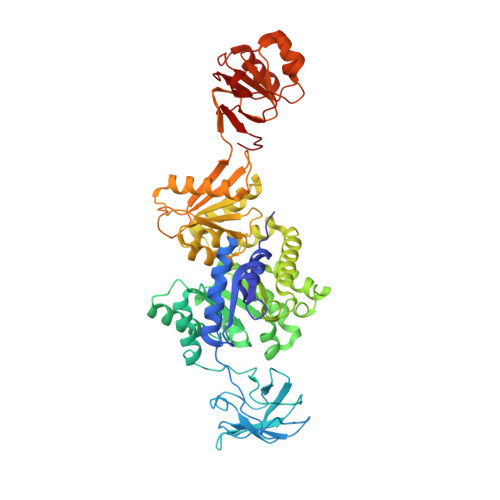Crystal structure of pyruvate kinase from Geobacillus stearothermophilus.
Suzuki, K., Ito, S., Shimizu-Ibuka, A., Sakai, H.(2008) J Biochem 144: 305-312
- PubMed: 18511452
- DOI: https://doi.org/10.1093/jb/mvn069
- Primary Citation of Related Structures:
2E28 - PubMed Abstract:
The pyruvate kinase (PK) from a moderate thermophile, Geobacillus stearothermophilus, is an allosteric enzyme activated by AMP and ribose 5-phosphate but not fructose 1, 6-bisphosphate (FBP), which is a common activator of PKs. It has an extra C-terminal sequence (ECTS), which contains a highly conserved phosphoenolpyruvate (PEP) binding motif, but its function and structure remain unclear. To elucidate the structural characteristics of the effector-binding site and the ECTS, the crystal structure of the C9S/C268S mutant of the enzyme was determined at 2.4 A resolution. The crystal belonged to space group P6(2)22, with unit cell parameters a, b = 145.97 A, c = 118.03 A. The enzyme was a homotetramer and its overall domain structure was similar to the previously solved structures except that the ECTS formed a new domain (C' domain). The structure of the C' domain closely resembled that of the PEP binding domain of maize pyruvate phosphate dikinase. A sulphate ion was found in a pocket in the effector-binding C domain. This site corresponds to the 6-phosphate group-binding site in yeast PK bound FBP and seems to be the effector-binding site. Through comparison of the structure of the putative effector-binding site to that of the FBP binding site of the yeast enzyme, the structural basis of the effector specificity of the G. stearothermophilus PK is discussed.
- Department of Food and Nutritional Sciences, University of Shizuoka, Yada 52-1, Shizuoka 422-8526, Japan.
Organizational Affiliation:

















